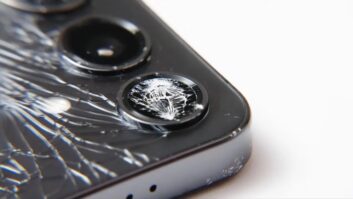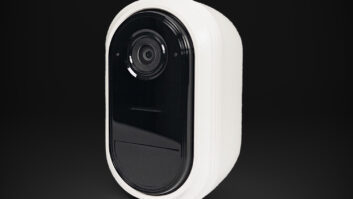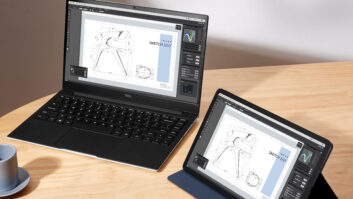BARCELONA, SPAIN — Smartphone introductions at the Mobile World Congress ranged from the low to the high tiers and included the first smartphones with 4K video capture, phablets with screen sizes up to 6.8 inches, and multiple phones with the latest Android OS, called KitKat.
Phones with 4K video capture included LG’s G Pro 2, Samsung’s Galaxy S5 and Sony’s Xperia Z2 flagship.
KitKat-OS phones were shown by Sony, Samsung, LG and Hisense. Screen sizes of many new phones ranged from 5.3 inches to 5.5 inches but ran up to 6.4 inches from Archos and 6.8 inches from Hisense. More phones also showed up with Wi-Fi 802.1a/b/g/n/ac.
Although companies such as LG, Sony and Samsung unveiled new top-tier phones, multiple companies – including LG, Sony, and HTC – filled added to their mid-tier segments to broaden the smartphone user base and tap into U.S. carriers’ desire to reduce handset subsidies. Some mid-tier models include LTE and Android KitKat.
Likewise, Microsoft took steps to bring its Windows Phone OS to lower price products and expand availability through more vendors.
Here’s a summary of key launches:
Archos expanded its line of Android smartphones but didn’t announce plans for U.S. availability. One of the new smartphones is the company’s first with octacore CPU, and another offers the company’s largest screen to date at 6.4 inches. All products access the Google Play store.
The three new Android smartphones are 3G GSM/ W-CDMA HSPA+21Mbps models. On an unlocked basis, two are priced at $199 and one at $119.
All new models feature Android 4.2 OS. The top model is the 50c Oxygen with 1.7GHz ocata-core CPU, 5-inch 1280×720 IPS screen, and 1GB RAM.
BlackBerry plans a second-half launch of a Black- Berry 10 OS smartphone with the traditional menu, back, send and end buttons and the integrated trackpad of pre-BlackBerry 10 OS phones. The phone will “enable the fast efficient navigation and one-handed use that has endeared the brand to its QWERTY customers,” the company said. It will also feature 3.5- inch touchscreen. Pricing and availability weren’t announced.
Hisense unveiled a 6.8-inch 4G LTE phablet and hopes to bring a similar device to the U.S. sometime this year, a spokesperson said. It would be the company’s first smartphone for the U.S. market.
The Maxe X1 can be paired with a Bluetooth handset to send and receive voice calls and text messages through the large-screen phablet.
The phablet runs the Android 4.4 KitKat OS and features Qualcomm Snapdragon 800 2.3GHz quad-core CPU and FullHD display.
HTC hopes to fuel its turnaround in part with the first model in a new-look HTC Desire family, which is designed to strengthen the company’s mid-tier presence.
The LTE-equipped Desire 816 features 5.5-inch 720p screen, quad-core 1.6GHz CPU, 1.5GB RAM, dual front speakers, HSPA+42Mbps, LTE, and nano SIM. U.S. availability will be announced in the coming months.
Lenovo debuted a trio of quad-core Android smartphones features 3G HSPA+, MediaTek 1.3GHz quadcore CPU, Android 4.2, and dual SIMs. The Lenovo S860, S850 and S660 start at $349, $269 and $229, respectively, and will be available in select markets and Lenovo.com in June. The S860 is the top model with 5.3- inch 720p HD screen and 2GB RAM.
The company declined to say whether the phones will come to the U.S., but a spokesman said Lenovo intends to begin selling Lenovo phones in “several mature-market countries in a phased rollout over the next two years.” including Western Europe and North America.
Microsoft expanded its roster of vendors supporting its OS and announced Windows Mobile support for the Qualcomm Snapdragon 200 and 400 series chipsets. The latter development will enable hardware vendors to use the same hardware for Android and Windows devices.
The new vendor partners are Lenovo, LG, ZTE, Foxconn, Gionee, JSR, Karbonn, Xolo and Longcheer, joining HTC, Huawei, Nokia and Samsung.
The company also relaxed hardware requirements for its OS, allowing soft buttons to replace physical camera and control buttons.
Samsung’s fifth-generation Galaxy S flagship adds stepped-up Wi-Fi and LTE performance, faster CPU, enhanced camera capabilities and fitness tools. The S5 is also the company’s first phone with fingerprint scanner, which appears on the screen to unlock the device, unlock user-specified content, and make secure mobile payments.
It will be available April 11 in almost 150 nations, including the U.S.
The 5.1-inch Android KitKat 4.4.2 phone is said to offer the fastest autofocus speed of any smartphone up to 0.3 seconds. It’s also the industry’s first phone with builtin heart-rate sensor, the first to combine Wi-Fi 802.11 ac with 2×2 MIMO to accelerate Wi-Fi speed, and the first to bond Wi-Fi and LTE to further accelerate data speeds.
The phone’s 5.1-inch FullHD screen is only slightly larger than its predecessor’s 5 inches. The CPU steps up to 2.5GHz quad core from 1.9GHz quad core, and LTE is upgraded to 150/50Mbps Category 4 LTE.
The phone also adds water- and dust-resistance, Wireless ANT+ technology, and ability to store and capture UHD 4K video at 30 fps. UHD video capture is also available on the company’s Note 3 5.7-inch phablet with SPen. Like before, it features 2GB RAM but now supports 128GB MicroSD cards.
Sony launched its first smartphone and first tablet with 4K video capture. A slim mid-range smartphone was also unveiled. All run the Android OS and feature 4G LTE.
The 4K phone and tablet, part of the premium Xperia series, will be available globally in March. The mid-tier phone will be available in April.
The 4K smartphone and tablet, both promoted as waterproof, are the company’s first with built-in noise-cancellation technology, said to reduce ambient noise up to 98 percent when used with a compatible wired noise-cancelling headset from Sony.
The 4K smartphone, the Xperia Z2, features FullHD 5.2- inch display, 20.7-megapixel camera, 2.3 GHz quad-core CPU, 3GB RAM, 8.2mm depth and dedicated camera button. It carries an IP55 rating for dust resistance and IP58 waterproof rating. The phone is promoted as offering “the world’s best camera and camcorder in a waterproof smartphone.” A new Timeshift mode lets users shoot video at 120 fps to create slow-motion effects.
The mid-tier M2 smartphone features 4.8-inch qHD display, Android 4.3, 1.2GHz quad-core CPU, 1 GB RAM and 8-megapixels camera.













